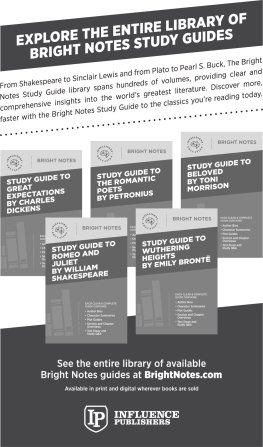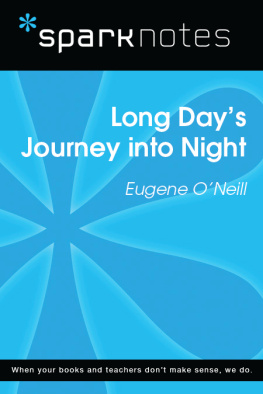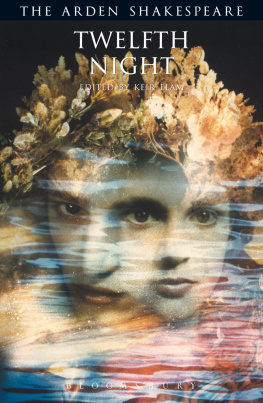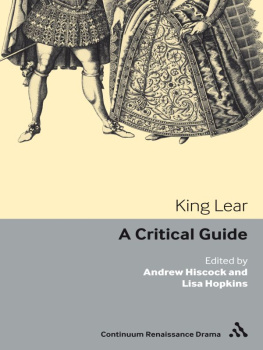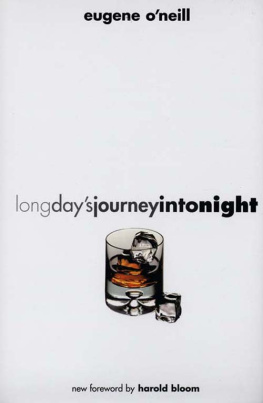Long Days Journey Into Night

LONG DAYS JOURNEY INTO NIGHT
EUGENE ONEILL
CRITICAL EDITION
Edited by William Davies King
Foreword by Jessica Lange

Foreword copyright 2014 by Jessica Lange.
Critical edition, including notes, chronology, essays, and bibliography, copyright 2014 by William Davies King.
Long Days Journey Into Night copyright as an unpublished work 1955 by Carlotta Monterey ONeill.
Copyright 1955 by Carlotta Monterey ONeill. First published February 1956. Copyright renewed 1984 by Yale University. Corrected edition copyright 1989 by Yale University.
All rights reserved.
This book may not be reproduced, in whole or in part, including illustrations, in any form (beyond that copying permitted by Sections 107 and 108 of the US Copyright Law and except by reviewers for the public press), without written permission from the publishers.
Yale University Press books may be purchased in quantity for educational, business, or promotional use. For information, please e-mail sales.press@yale.edu (US office) or sales@yaleup.co.uk (UK office).
Frontispiece: Eugene ONeill in 1939, at the time of writing Long Days Journey Into Night (Photo Horace Bristol/Corbis. Louis SheafferEugene ONeill Collection, Linda Lear Center for Special Collections & Archives, Connecticut College)
Printed in the United States of America.
Library of Congress Control Number: 2013956573
ISBN: 978-0-300-18641-3 (pbk.)
10 9 8 7 6 5 4 3 2 1
CAUTION: Professionals and amateurs are hereby warned that Long Days Journey Into Night, being fully protected under the copyright laws of the United States of America, the British Commonwealth, including Canada, and all other countries of the copyright union, is subject to royalties. All rights, including professional and amateur performance, motion picture, recitation, public reading, radio broadcasting, and the rights of translation into foreign languages, are strictly reserved. All inquiries regarding production rights to this play should be addressed to International Creative Management (ICM), 730 Fifth Ave., New York, NY 10019, Attn. Val Day. All other inquiries should be addressed to Yale University, Office of the General Counsel, PO Box 208255, New Haven, CT 065208255.
THE EUGENE ONEILL COLLECTION was founded at the Yale University Library in 1931 by Carlotta Monterey ONeill. It includes notes, photographs, and the manuscripts of plays, among them long days journey into night. All royalties from the sale of the Yale editions of this book go to Yale University for the benefit of the Eugene ONeill Collection, for the purchase of books in the field of drama, and for the establishment of Eugene ONeill Scholarships in the Yale School of Drama.
Contents
Foreword
Jessica Lange
I had the opportunity of doing a production of Long Days Journey Into Night in London some years ago. There are roles that arrive like gifts. Given and received. Mary Tyrone was that. No part I have played on stage or in film has ever captured me more. Actors can fall in love with characters they play, obsess over them, cling to them... sometimes were haunted by them.
I loved Mary Tyrone. I longed to get to the theater each evening so I could experience her. So I could lose myself in her. The part of Mary Tyrone is a bottomless well. Impossible to exhaust.
We went into rehearsals in late fall and played through the long winter of 20002001. London is the perfect setting to experience this masterful play. The gloom and dampness, the fog and the grayness mirror the atmosphere of the play.
Our set was more dreamlike than what ONeill describes in the stage directions. It had a ghostly feel, more memory than reality. As the light moved east to west across the stage during the course of the long day, the fog seemed to seep through the walls. The foghorn a constant reminder of old sorrows... a plaintive, haunting refrain.
Why is it fog makes everything sound so sad and lost, I wonder?
Memorizing lines proved difficult at first. I found I would oft en lose track of where I was in the play. I came to understand it was due to the circular nature of the play, which is structured like a piece of music where the composer creates a melody and then repeats it again and again in altered forms. Theme and variations. The cycles of punishment and forgiveness, recriminations and excuses. A tragic score of love and hate.
It is linear only in the passage of time, morning to night, and the effects of the morphine increasing steadily as the day wears on.
Marys addiction has been singled out in the family as the greatest transgression. But there are four addicts living in that house. The men are alcoholics. Morphine is less acceptable, less social, more mysterious, and therefore more isolating. It sets Mary apart, separating her even more from the rest of them.
One heroin addict I talked to when I was preparing to do the play described how it felt like being wrapped in a warm blanket. I imagine thats what Mary is looking for.
But like many addicts, she is a master of deceit, a champion liar.
How could you believe mewhen I cant believe myself ? Ive become such a liar.
Mary is also a master of manipulation. She controls every moment she is on stage, and at the same time she is barely in control of herself. Her innocence and helplessness and, in the next moment, her capacity for cruelty, to wound those she loves the dearest. Her shifting alliances, her need to lay blame, to accuse and then excuse. To punish and then forgive. She is the most complex and fully realized character I have ever played.
Mary is torn between her love and her need for her husband and sons and her desire to lose herself in the morphine: to disappear.
Youre lying to yourself again. You wanted to get rid of them. Their contempt and disgust arent pleasant company. Youre glad theyre gone. Then Mother of God, why do I feel so lonely?
It is these contradictions and the layering of emotionswoven into a patchwork pattern of sorrow, grief, guilt, anger, blame, love, desire, hatethat make Mary a profound and fascinating character. Playing multiple emotions in the same moment is exciting. Her elusiveness and quicksilver shifts are thrilling. The fluidity and velocity are staggering but feel inevitable. In a single page of dialogue with James, ONeill describes some of these shift s: forcing a laugh... sharply... then pleadingly... with dull anger... in stubborn defiance... then accusingly... bitterly... pleadingly... strickenly... slipping away into her strange detachmentquite casually... piteously... into that stubborn denial again.
I have always considered this play a great love story. Mary and James share a deep and abiding devotion to each other. The memory of their passion and romance is so close to the surface. Those memories are in their fingertips when they touch.
When she tells Cathleen of their first meeting, you hear the girl her sensuality, her sexual discovery. She loves this story. How, in her innocence and beauty, she won the most handsome, famous man of the day. How they fell deeply in love and couldnt bear to be separated. The evocation of that moment transports her out of this place she despises. It is a classic sense-memory exercise for an actor.
But it is a story of a great love damaged by loneliness and despair, by disappointment. Those romantic stories exist hand in hand with the most grievous memories.
Next page


